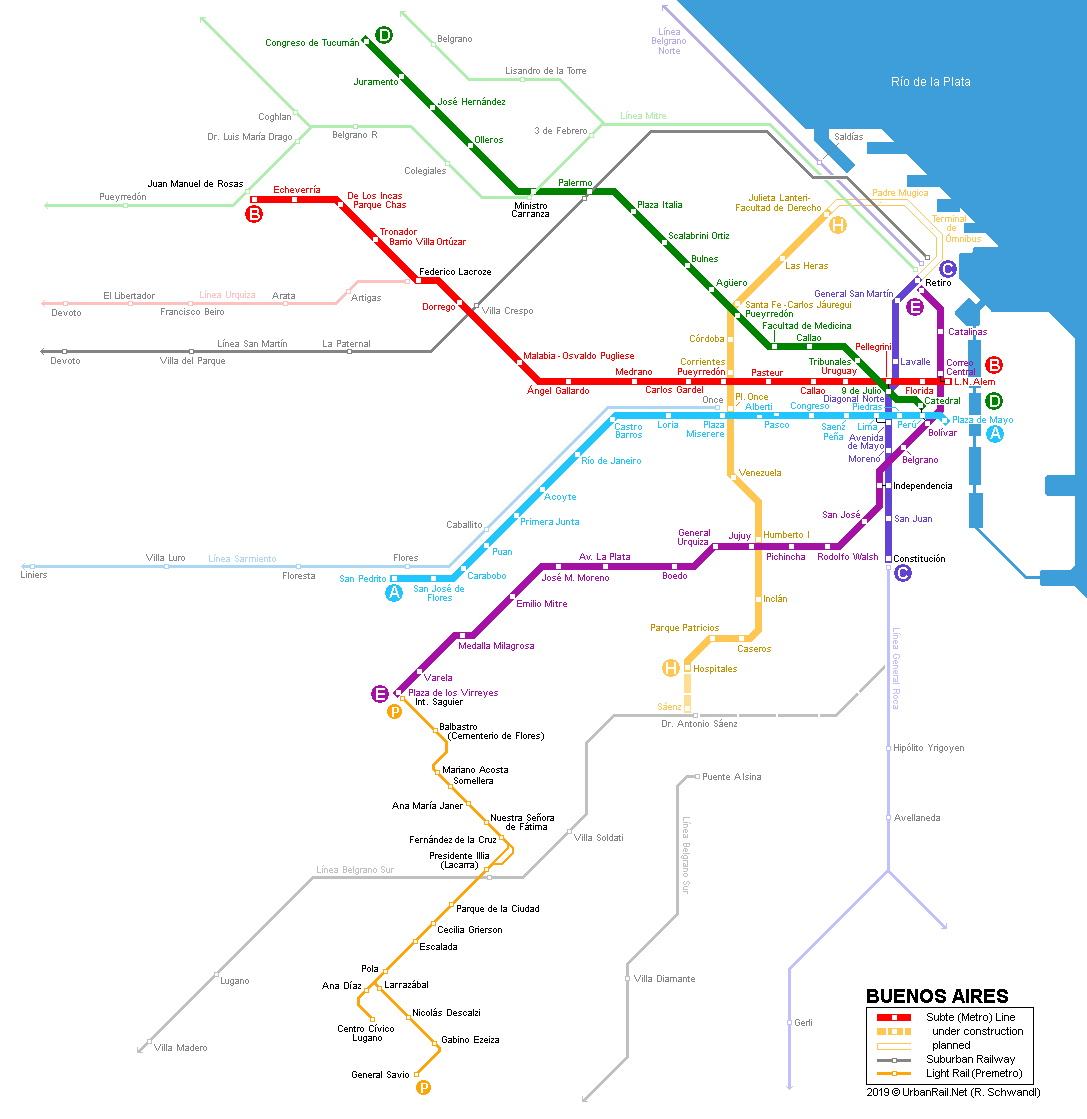
|
[ UrbanRail.Net ] [ Europe ] [ Americas ] [ Asia ] [ Africa ] [ Oceania ] [ News ] [ Books ] [ Links ] [ Blog ] [ Shop ] |
|
BUENOS
AIRES
|
| Argentina |

|
SUBTE
|
||
|
Buenos Aires, the capital of Argentina, is one of South America's biggest cities with 3 million inhabitants (Ciudad Autónoma de Buenos Aires) and 12 million in the larger metropolitan area (Gran Buenos Aires). For a city of this size the metro network is still very small although it's by far the oldest subway in South America. After losing many passengers during the 1980's, the Subte was privatised and was then operated by Metrovías which immediately started refurbishing stations and buying new rolling stock to replace older trains, some of which had been running since the Subte opened. On 1 Dec 2021 (until 2033), the new operator became Emova Movilidad, a company formed by Metrovías and Benito Roggio Transporte. The total network is approx. 54 km (06/2019) and totally underground.
|
||
| Línea A | 9.8 km, 18 stations | |
|
01/12/1913
- Plaza de Mayo - Plaza Miserere |
||
| Línea B | 12.5 km, 17 stations | |
|
17/10/1930
- Federico Lacroze - Callao |
||
| Línea C | 4.4 km, 9 stations | |
|
09/11/1934
- Constitución - Diagonal Norte |
||
| Línea D | 11 km, 16 stations | |
|
03/06/1937
- Catedral - Tribunales (1.7 km) |
||
| Línea E | 11.2 km, 18 stations | |
|
20/06/1944
- San José (Plaza Constitución) - General Urquiza
(3 km) March 2013: Entre Ríos station renamed into Rodolfo Walsh |
||
| Línea H | 8 km, 12 stations | |
|
18/10/2007:
Once - Caseros (2.9 km) |
||
| Premetro | ||
|
Apart from the Subte there is a 7.4 km light rail line (called Premetro and opened in 1987) which serves the southwestern part of the city from Line E's terminus at Plaza de Los Virreyes.
|
||
| Tren de la Costa | ||
|
Standard-gauge light rail line electrified with overhead catenary in the north of the metropolitan area, connecting to the Bartolomé Mitre branch of the Línea Mitre: 15.5 km, 11 stations, every 20-30 minutes
|
||
| Suburban Railways | ||
|
Besides the Subte, Buenos Aires has numerous suburban railways, some operated with diesel and some with electric trains: 1)
Ferrocarril Urquiza: standard-gauge with 3rd rail power supply, running
west from Federico Lacroze, operated by Metrovías |
||
|
Projects |
||
|
Current projects: Line H: Southern extension from Hospitales to Saenz Mid-term projects: Line H - northern section Facultad de Derecho to Retiro Long term plans include several north-south routes to create a proper network avoiding the city centre: Line
F - 8.6 km - from Plaza Italia (Line D) to Constitución
(Line C); later south to Barracas. - The former project to extend Line D from Congreso de Tucumán to Manuel Pedraza, was indefinitely postponed. See Map1 (thanks to Jordi Serradell) and map2 (thanks to Mariano Hellmuth-Gómez) with possible future lines. |
||
|
Photos
|
||
|
Links
|
||
|
Metrovías S.A. Subte Operator (Official Website) Official Integrated Map with Subte and Suburban Railways by Gagin Studio Graphic Design Trenes Argentinos (Most Suburban Railways) En el Subte by Martín Machain Subte & Premetro at Wikipedia.es Ferrocarriles Metropolitanos de Buenos Aires at Wikipedia.es Allen Morrison's BA Electric Railways Map Map showing future extensions by Jordi Serradell UrbanRail.Net > B.A. Subte Photo Gallery ALAMYS - Asociación Latinoamericana de Metros y Subterráneos |
||
|
|
||
2007 © Robert Schwandl (UrbanRail.Net)
LIST OF STATION RENAMINGS AFTER 1970 (Thanks to Daniel Monteros):
Línea A:
Medrano >> Castro Barros
José María Moreno >> Acoyte
Línea B:
Aguero >> Carlos Gardel
Río de Janeiro >> Angel Gallardo
Canning >> Malabia
Línea
D:
Florida >> Catedral
Carlos Pellegrini >> 9 de Julio
Canning >> Scalabrini Ortiz